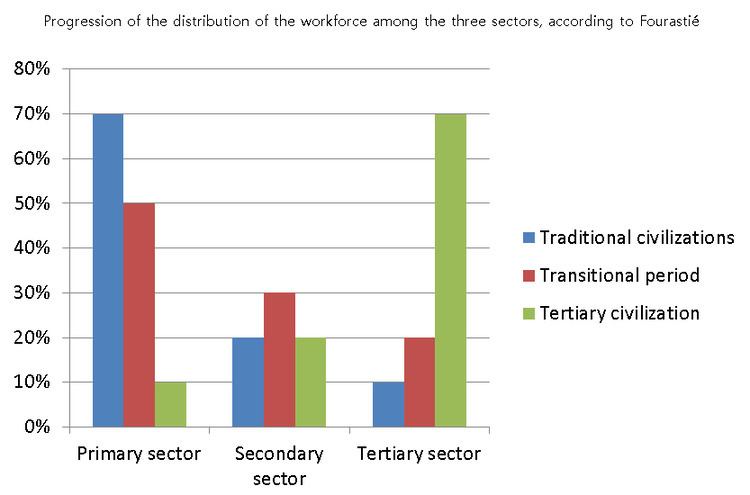 | ||
The three-sector theory is an economic theory which divides economies into three sectors of activity: extraction of raw materials (primary), manufacturing (secondary), and services (tertiary). It was developed by Allan Fisher, Colin Clark and Jean Fourastié.
Contents
- Structural transformation according to Fourasti
- First phase Traditional civilizations
- Second phase Transitional period
- Third phase Tertiary civilization
- References
According to the theory, the main focus of an economy's activity shifts from the primary, through the secondary and finally to the tertiary sector. Fourastié saw the process as essentially positive, and in The Great Hope of the Twentieth Century he writes of the increase in quality of life, social security, blossoming of education and culture, higher level of qualifications, humanisation of work, and avoidance of unemployment.
Countries with a low per capita income are in an early state of development; the main part of their national income is achieved through production in the primary sector. Countries in a more advanced state of development, with a medium national income, generate their income mostly in the secondary sector. In highly developed countries with a high income, the tertiary sector dominates the total output of the economy.
Structural transformation according to Fourastié
The distribution of the workforce among the three sectors progresses through different stages as follows, according to Fourastié:
First phase: Traditional civilizations
Workforce quotas:
This phase represents a society which is scientifically not yet very developed, with a negligible use of machinery. The state of development corresponds to that of European countries in the early Middle Ages, or that of a modern-day developing country.
Second phase: Transitional period
Workforce quotas:
More machinery is deployed in the primary sector, which reduces the number of workers needed. As a result, the demand for machinery production in the secondary sector increases. The transitional way or phase begins with an event which can be identified with the industrialisation: far-reaching mechanisation (and therefore automation) of manufacture, such as the use of conveyor belts.
The tertiary sector begins to develop, as do the financial sector and the power of the state.
Third phase: Tertiary civilization
Workforce quotas:
The primary and secondary sectors are increasingly dominated by automation, and the demand for workforce numbers falls in these sectors. It is replaced by the growing demands of the tertiary sector. The situation now corresponds to modern-day industrial societies and the society of the future, the service or post-industrial society. Today the tertiary sector has grown to such an enormous size that it is sometimes further divided into an information-based quaternary sector, and even a quinary sector based on human services.
